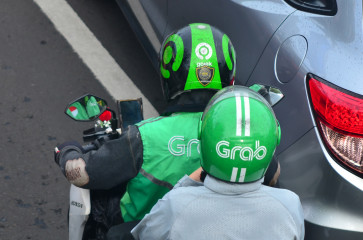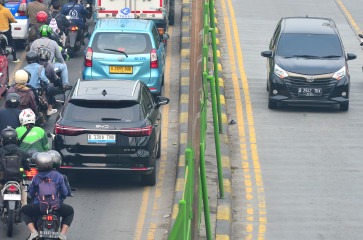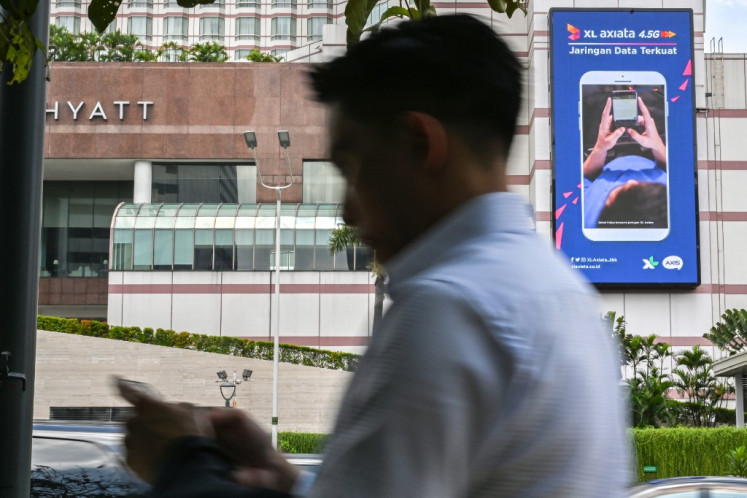Popular Reads
Top Results
Can't find what you're looking for?
View all search resultsPopular Reads
Top Results
Can't find what you're looking for?
View all search resultsFlamenco Daminaro: The rhythm of the night
Daminaro flamenco dance company performs Cae La Noche at Jakarta Playhouse
Change text size
Gift Premium Articles
to Anyone
Daminaro flamenco dance company performs Cae La Noche at Jakarta Playhouse.
As the dazzling sun bids us goodbye, the mysterious night greets the Earth with the story of the birth of her children: Doom, Death and Dream.
Thousands of miles away from their hometown of Madrid, the four dancers of Flamenco Daminaro sway Jakarta in Cae La Noche (Nightfall), a passionate four-part synthesis of flamenco dance and Greek mythology.
The performance at the Jakarta Playhouse (GKJ) opens with “The Nymphs of the Sunset”. A male and female dancer, both entirely in black, trade verses of the cante flamenco, a flamenco song, about the beginning of the night’s journey. Palmas, (handclapping interspersed with the singing) follows the beat and rhythm of the guitar. A fusion of the sounds of human voices and bodies with the complex counterpoint of gypsy guitar fills the auditorium.
Four flamenco dancers of Daminaro showcase “The Eternal”. In this sequence, each dancer also demonstrates his or her skills in dance battle.
Daminaro’s three bailaoras (female dancers) – Natalia Martinez, Rocio Martin and La Popi – take front stage before the singers. In the flamenco style of bright red gowns with long-sleeved black boleros, they answer the musical statement with a fervent dance, portraying the beauty and power of the goddesses of Greek myth.
Their fluid movements, expressed in the flamenco way, produce a cacophony of stamping, clicking and clapping as the dancers feet, hands and fingers engage the musicians in a highly disciplined display of passion, deception and dreams, with perhaps a tinge of regret.
The only male dancer in the cuadro (troupe), Dario Alanis, enters. In the signature red and black of Daminaro, Alanis takes over the whole stage. With his disjointed movements, Alanis showcases the masculine strength in flamenco fusion, which is all about vigor and strength.
In “Night and Day” the bailadoras, again in red and black bata de cola (a flamenco dress with long train) continued their routine with tap dancing, hand clapping, finger snapping, chest and thigh patting. High kicks into their gowns’ trains flared into the night. The true signature of flamenco.
The lights are dimmed. A solo female dancer poses in black and white at the side of the stage, before she steals the show as she dances “Dream and Fantasy” under the spotlight
Her hands and body express a furious and fervent lust for life. She increases her pace. Her footwork becomes faster and faster, stomping on the floor, striking the boards with the balls of her feet and heels.
Daminaro’s singers, Pedro Obregon (left) and Loreto De Diego, are on the stage with guitarist Victor “El Tomate” Marquez (right).
All of a sudden, a man takes the limelight. He is her fantasy. He captures her attention and her emotions with the depth and strength of his dance, his macho charisma dominating the stage.
When at last she joins him under the glare of the spotlight, the couple collaborates with one another in a cohesive choreography of one perfect rhythm entwined in another.
Turn and turn about, both dancers express their flaming love with loud bravura. The woman accentuates her exquisiteness, while her man exudes vitality and verve in sprays of sweat which splash along the shafts of light. This is no mere corporeal companionship.
The cantaores, flamenco singers, return to rule the arena. A cantaora improvises in a loud, high, muscular vibrato accompanied by the relentless hand-clapping and clattering of the tocaor (guitarist).
Later, in solo, the tocaor demonstrates the famous flamenco melodies in a sophisticated torrent of timing, speed and romance.
The three female dancers are now each on their own black chairs, this time in glorious blue gowns for “Deception and Passion”, the third installment of the tetra logy. With a singing from Pedro Obregon, all of the dancers performed unique hand routines. Then, each dancer stood in turn, performing their own inimitable flamenco routine: their party piece. While one dancer was on the go, others looked on, clapping in support of the main performer.
Then Alanis entered. And the four danced together.
In the last segment, “The Eternal”, all four dancers, now in black-and-white, shared the arena, dancing in a similar slow motion, before each performed a solo routine, surrounded by others, each faster and more fervent than the last until the shout went up from Obregon for “Caballero!” and Alanis stepped up into the center of the dancers’ circle to show more of his skills.
Eventually the music could grow no louder or faster and it all suddenly stopped, in a dramatic, impassioned stance, and sustained applause.












